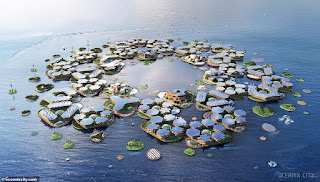The world's first floating city will soon be built in South Korea in 2025. The goal is as a solution for humans to survive the threat of rising sea levels in the future due to climate change.
Backed by the United Nations, the floating city near the coast of Busan is designed to be flood-resistant and can rise as sea levels rise. The shape is in the form of hexagonal man-made islands. The material is reinforced with a layer of limestone which is strong and lightweight, resistant to bad weather conditions.
If it has been realized, the city is designed to meet its own food, energy and clean water needs. There is a kind of cage at the bottom for producing seafood. Plants for consumption are grown in a sophisticated system.
Powered by solar panels and reinforced by anchors on the seabed. So this floating city can withstand a tsunami or a big storm. While the cost is estimated at USD 200 million.
"Long-lasting floating cities are part of the weapons as an adaptation strategy available to us related to climate. Instead of fighting water, let's learn to live in harmony with it," said Maimunah Mohd Sharif, Executive Director of UN Habitat.
"We are looking forward to developing climate adaptation and nature-based solutions through this floating city concept and Busan is the ideal choice to build this prototype," he added.
Busan is one of the busiest port cities so many residents there are experts and have experience of the oceans to support this ambitious project.
It has not been announced how big the floating city is, but it is estimated that it can accommodate up to 10 thousand residents. It is also not known whether the system is for sale or lease.


